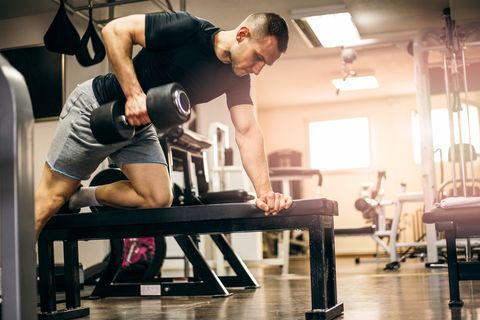The traditional single-arm dumbbell row is one of the best exercises you can do for your back. It’s also an exercise that, for all the wrong reasons, often relies on a bench.
You’ve seen this too. You walk into a gym and see somebody with their right leg planted into the bench, almost driving their right knee into the platform. Their left arm holds a dumbbell, and their left foot is planted into the ground. The stance is standard dumbbell row practice.

This way or working is also not the best option. Why? Because it invites you to completely ignore core stability. During just about every exercise, you want your abs and glutes firing, keeping your torso completely stable. But the moment you assume this imbalanced dumbbell row stance, you place your hips in an increasingly compromising position. It’s tougher to focus on keeping a neutral spine here, so your lower back can easily start rotating downwards towards the side of the dumbbell, or overcompensating by twisting the other way. Neither of these situations places you in an advantageous position to pull.
Your better alternative is this: Ditch the bench entirely. Set up with both feet flat on the floor in a balanced stance. Bend your knees slightly, and hinge forward at the hips until your back is nearly parallel with the ground. This lower-body setup gives you balance, and it allows you to fire those ab muscles consistently too. You can now focus on keeping your hips square to the ground the entire time, recruiting abs and glutes for the life of a set, keeping your core turned on for every single rep.
That’ll result in three things. First of all, you’ll be able to attack your rhomboids and lats more aggressively when you row, taking your lower back out of the equation. Second, by keeping your lower back steady and stable, you’ll shield it from any injury. Lastly? You’ll draw more consistent core and glute activation and awareness during every rep and every set.
This is the better, smarter way to do dumbbell rows. So make the changes right now, and expect increased back (and total body) muscle and strength.

Source: Read Full Article
